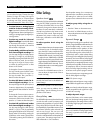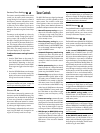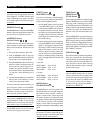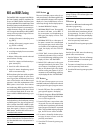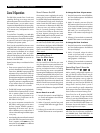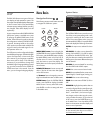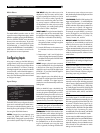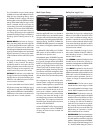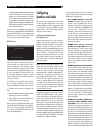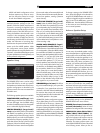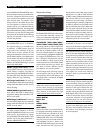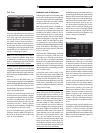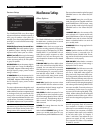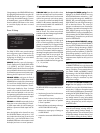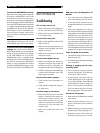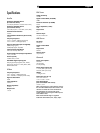
38
RSX-1056 Surround Sound Receiver
no center width spreading and all of the center
channel information is sent to the center
speaker. The maximum setting of 7 shifts all
of the center channel signal to the left and
right speakers, essentially muting the center
speaker and maximizing the soundfield width.
Other settings provide incremental steps be-
tween the two extremes.
When you have completed all the desired
adjustments, highlight the INPUT SETUP MENU
line at the bottom of the screen and press the
ENTER button to return to the INPUT SETUP
menu (or just press the ENTER button).
DTS Neo:6
DTS Neo:6
MODE:Cinema
INPUT SETUP MENU
When DTS Neo:6 is selected as the default
surround mode on the INPUT SETUP menu,
there are additional option settings and pa-
rameters available to optimize the surround
decoding for various types of recordings, music
or movie soundtracks. DTS Neo:6 uses ma-
trix decoding algorithms to derive a center
channel and surround channels from 2-chan-
nel source material.
In DTS Neo:6 surround mode, there will only
be one choice available on the sub-menu:
selecting CINEMA or MUSIC modes. Use the
+/– buttons on the remote to change the set-
tings.
• Select CINEMA to optimize the DTS Neo:6
decoding for movie soundtracks.
• Select MUSIC to optimize the DTS Neo:6
decoding for musical recordings.
When you have completed the setting, high-
light the INPUT SETUP MENU line at the bot-
tom of the screen and press the ENTER but-
ton to return to the INPUT SETUP menu (or just
press the ENTER button).
Configuring
Speakers and Audio
This section of the setup process covers items
concerning audio reproduction such as the
number of speakers, bass management includ-
ing subwoofer crossovers, establishing equal
output levels for all channels, delay settings,
and tone contour settings.
Understanding Speaker
Configuration
Home theater systems vary in the number of
speakers and the bass capabilities of those
speakers. The RSX-1056 offers surround modes
tailored to systems with various numbers of
speakers and bass management features which
send bass information to the speaker(s) best
able to handle it – subwoofers and/or large
speakers. For optimum performance, you must
tell the RSX-1056 the number of speakers in
your system and how bass should be distrib-
uted among them.
NOTE
: There are two types of bass in a sur-
round system. The first is bass recorded in each
of the main channels (front, center, and sur-
round). This bass is present in all recordings
and soundtracks. In addition, Dolby Digital 5.1
and DTS 5.1 recordings may have a Low Fre-
quency Effects (LFE) channel – the .1 channel.
This LFE channel, typically played by a sub-
woofer, is used for effects such as explosions
or rumble. The use of the LFE channel will vary
from soundtrack to soundtrack. Recordings that
are not encoded in Dolby Digital or DTS do
not have the LFE channel.
The following configuration instructions refer to
LARGE and SMALL speakers, referring more
to their desired bass configuration than their
physical size. Specifically, use the LARGE set-
ting for speakers that you want to play deep
bass signals. Use the SMALL designation for
speakers that would benefit from having their
bass sent to more capable speakers. The bass
management system redirects bass information
away from all SMALL speakers and sends it to
the LARGE speakers and/or the SUBWOOFER.
It may be useful to think of LARGE as “full-range”
and SMALL as “high-pass filtered.”
Four typical examples of the many possible
system configurations illustrate the principles
behind bass management:
• Five LARGE speakers and sub-
woofer: This system requires no bass re-
direction. All five speakers play the nor-
mal bass recorded in their respective chan-
nels. The subwoofer plays only the LFE
channel bass. Depending on the
soundtrack, there may be minimal use of
the LFE channel, so the subwoofer would
be under utilized. Meanwhile the normal
bass places higher demands on the capa-
bilities of the other speakers and the am-
plifiers driving them.
• LARGE front, center, surround
speakers, no subwoofer. The normal
bass from the front, center, and surround
channels is played in its respective speak-
ers. With no subwoofer, the LFE bass is re-
directed to all five LARGE speakers. This
places significant demands on these speak-
ers and their amplifiers, as they must play
their own normal bass plus the very demand-
ing LFE bass.
• All SMALL speakers and subwoofer.
The normal bass from all channels is redi-
rected to the subwoofer, which also plays
the LFE channel. The subwoofer handles
ALL of the bass in the system. This configu-
ration provides several benefits: deep bass
is played by the speaker most suited to do
so, the main speakers may play louder with
less distortion, and the need for amplifier
power is reduced. This configuration should
be used with bookshelf-size or smaller main
speakers. It should also be considered in
some cases with floorstanding front speak-
ers. This configuration is advantageous
when driving the system with moderate
power amplifiers.
• LARGE front speakers, SMALL cen-
ter and surround speakers, and a
subwoofer. The normal bass from the
SMALL center and surround speakers is re-
directed to the LARGE front speakers and
the subwoofer. The LARGE front speakers
play their own normal bass plus the redi-
rected bass from the SMALL speakers and
LFE bass. The subwoofer plays the LFE bass
plus the redirected bass from all of the other
channels. This might be an appropriate con-
figuration with a pair of very capable front
speakers driven by a large power ampli-
fier. A potential disadvantage with mixed



